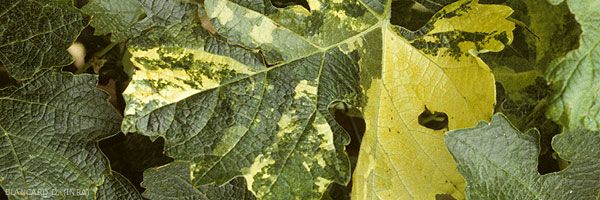
Genetic abnormalities
Genetic abnormalities are due to mutations in the DNA of grapevine cells. These mutations occur randomly and have more or less important consequences on the vine. At least 2 genetic anomalies are known in this vitaceae which are quite frequent: variegation or variegation, and fasciation. You should be wary as these genetic abnormalities can be transmitted during vegetative reproduction.
- Variegation / variegation
This genetic condition causes a change in the coloring of the organs of the vine, in particular the herbaceous parts and the berries. We mainly observe discolorations, the organs showing well-demarcated sectors of yellow to white color contrasting with the natural color of the other parts which are not affected (figures 1 and 2).
In fact, the genetic mutation calls into question the influence of photosynthesis, and in particular the synthesis of pigments in cells, so it is not surprising to observe discolorations.
The symptoms will be more or less extensive depending on the stage of development of the affected organ and the affected tissue. Note that the earlier the mutation is expressed, the greater the number of organs and the surface area affected.
In fact, the genetic mutation calls into question the influence of photosynthesis, and in particular the synthesis of pigments in cells, so it is not surprising to observe discolorations.
The symptoms will be more or less extensive depending on the stage of development of the affected organ and the affected tissue. Note that the earlier the mutation is expressed, the greater the number of organs and the surface area affected.
- Fasciation
This other genetic anomaly is characterized by flattening and grouping of the stems, petioles and pedicels of the clusters. It is due to a mutation manifesting itself in the meristems which do not have a normal form.
This genetic anomaly should not be confused with the fasciations associated with various parasitic diseases linked in particular to viruses.
This genetic anomaly should not be confused with the fasciations associated with various parasitic diseases linked in particular to viruses.





